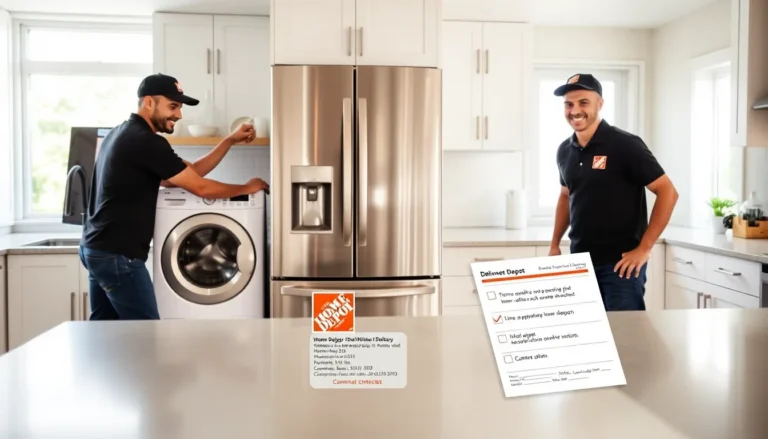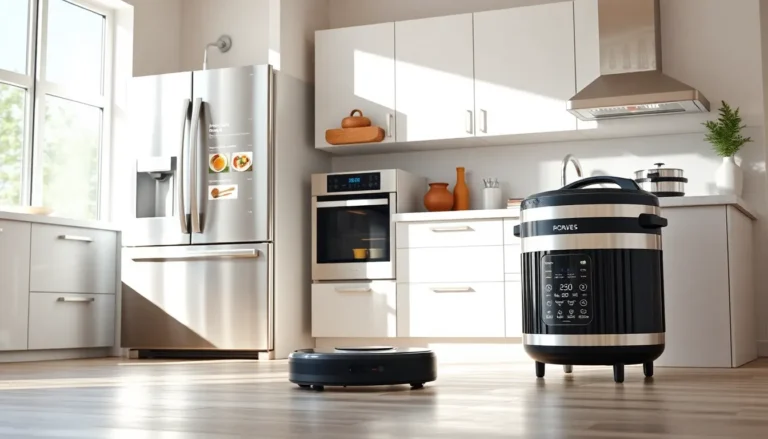Did you know your beloved appliances might have a secret superhero waiting to protect them? That’s right. Home insurance designed to shield your appliances from unforeseen disasters is actually a thing. With the right coverage, your fridge, washing machine, and even that fancy espresso maker can rest easy. Immerse to discover how home insurance protects your household against appliance disasters, how to choose the right policy, and all the nitty-gritty details to keep your home running smoothly.
Table of Contents
ToggleUnderstanding Home Insurance Basics

Home insurance is like a safety net for your home and belongings. It furnishes peace of mind by providing financial protection against various perils, including fire, theft, and natural disasters. Most homeowners don’t realize that not all policies are created equal. Understanding the basics of home insurance is essential before making a decision that could impact your wallet and your appliances.
Typically, home insurance consists of two primary components: the dwelling coverage and personal property coverage. Dwelling coverage protects the structure of your home, while personal property coverage insures your belongings, including appliances. Knowing which policy best suits your needs is crucial, especially if appliances form a significant part of your household expenses.
Types of Coverage Options
Not all home insurance policies offer the same types of coverage, and being aware of your options can lead to better decisions. Broadly speaking, policies can be categorized into two types: actual cash value (ACV) and replacement cost value (RCV).
- Actual Cash Value (ACV): This method pays for your appliances based on their current market value minus depreciation. So, if your six-year-old washing machine breaks down, you’ll receive a payment that considers its age and wear.
- Replacement Cost Value (RCV): This option is a bit sweeter. It provides a payout sufficient to replace your appliance with a new model, regardless of depreciation.
When choosing a policy, consider which approach suits your financial situation better. While ACV may come with lower premiums, RCV can lead to significant savings in case of appliance loss.
What Appliances Are Typically Covered?
So, which appliances are usually on the guest list for home insurance coverage? Generally, homeowners can expect coverage for major appliances. These typically include:
- Refrigerators: Essential for keeping food fresh and beverages cold.
- Washers and Dryers: No one wants to haul laundry to a laundromat, right?
- Dishwashers: Because who has the time to wash dishes by hand?
- Ovens and Stoves: Cooking would be nearly impossible without these apps.
But, it’s vital to read the fine print. Some policies may exclude certain items or offer limited coverage based on the appliance’s age or condition.
Factors Influencing Appliance Coverage
Several factors can impact the extent of appliance coverage in a home insurance policy. For starters, the policyholder’s location plays a crucial role. Areas prone to natural disasters may necessitate higher premiums or additional riders for comprehensive coverage.
Also, the age and condition of appliances matter. Newer appliances may be covered more comprehensively compared to older models. Insurers often outline specific requirements or restrictions about older devices, so staying informed is essential.
Finally, the type of home insurance policy selected directly influences coverage. Hence, always compare policies to ensure you’re getting appliances covered adequately.
Tips for Choosing the Right Home Insurance
Navigating home insurance isn’t exactly a walk in the park, especially with so many options out there. Follow these tips to ease the process of choosing the right coverage for your appliances:
- Assess Your Needs: Start with a thorough evaluation of the appliances in your home and their value. This assessment will guide your insurance needs.
- Compare Policies: Don’t settle for the first offer. Shop around and compare coverage options and premiums across different providers.
- Ask Questions: If something isn’t clear, don’t hesitate to reach out to insurers. Understanding policy details is key to avoiding unpleasant surprises during claims.
- Consider Bundling: Sometimes insurers offer discounts for bundling home and auto insurance. This bundling can lead to savings while ensuring comprehensive coverage.
Claim Process for Appliance Coverage
If the unfortunate happens and an appliance breaks down or is damaged, knowing how to file a claim is essential. Here’s a straightforward guide to the typical claims process:
- Document the Damage: Take clear photos and write down pertinent details about the incident to help substantiate your claim.
- Contact Your Insurer: Reach out to your home insurance provider as soon as possible. Prompt notification is crucial for swift processing.
- Filing a Claim: Follow instructions from your insurer about submitting a claim. They may request specific information or documents.
- An Adjuster Reviews Your Claim: After filing, an insurance adjuster may come to assess the damage or loss claimed.
- Receive Payment: If your claim is approved, you’ll receive the appropriate compensation based on your policy’s terms. It could take some time, but patience is key.





